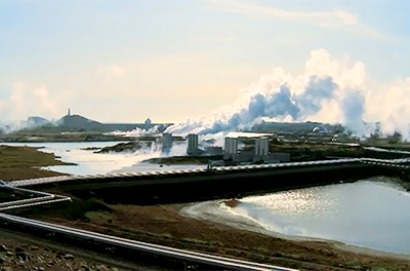
Both look to Kenya's Olkaria geothermal plant, on the boundaries of Hell’s Gate National Park, to deliver this new electricity. Olkaria, which has received long-term support from the World Bank and other agencies, is part of Kenya’s plan to substantially increase the contribution of geothermal to the country’s energy mix.
Only 16 percent of Kenyans have access to electricity, but with evidence of abundant geothermal resources beneath the country’s share of East Africa’s Rift Valley, the government plans to double geothermal generation to bring electricity to villages like Inkoiriento. Already, geothermal — developed with $300 million in support from the World Bank since 1978 — delivers about 13 percent of Kenya’s electricity; the goal is to raise that proportion to close to 30 percent by 2020.
Hairdresser Elizabeth Kyalo and her assistant now use electric appliances to straighten, dye, and style their customers’ hair. Electric lighting allows them to stay open after dusk: “I have more business now and am able to pay for schooling of my kids,” said Elizabeth.
Getting access to electricity also improves safety for women in remote areas. Before Kola Division village got electricity, for example, resident Jossylyn Mutua was attacked by machete-wielding thieves who sliced her forehead and smashed her arms. She has since relocated to Nairobi but would consider moving back to her village now that it has electricity.
“Lighting has secured the area,” said Norman Mulei, a grocer, a few shops away. He and his sister run their grocery from 6 a.m. to 8 or 9 p.m. They feel that having electricity has made it safer for them to stay open at night.
Concerted global action key to providing access
Geothermal is also delivering carbon-free access to electricity. “It is relatively clean and non-polluting, and can provide constant power,” says Pierre Audinet, Clean Energy Program Team Leader at the World Bank’s Energy Sector Management Assistance Program (ESMAP). “For many developing countries, this is a potentially transformative resource.”
Getting to that transformation, however, will take concerted international action.
Many other countries share Kenya’s prospects. Geothermal resources are concentrated in regions of tectonic activity, from Africa’s Rift Valley, to Central America, to Southeast Asia. About 40 countries worldwide have geothermal resources that could meet a very significant portion of the national electricity demand.
The World Bank and ESMAP are preparing a Global Geothermal Development Plan to mobilize funding for geothermal development. This partnership with bilateral funding agencies and other multilateral banks will target regions of high potential and finance the test drilling phase, to trigger further private investment along other stages of the geothermal value chain. The goal is to boost geothermal electricity production capacity in low- and middle-income countries, and thereby deliver power to some of the 1.3 billion worldwide who remain without it.
World Bank support for scaling up geothermal
Supporting the scale-up of geothermal power in developing countries is among the Bank Group’s key commitments as part of the global Sustainable Energy for All initiative, which aims to achieve universal energy access, double the proportion of renewable energy in the global energy mix, and double the rate of improvement of energy efficiency, all by 2030. Bank Group President Dr. Jim Yong Kim recently joined with UN Secretary-General Ban Ki-moon to co-chair the advisory board that will provide strategic guidance to the Sustainable Energy for All initiative.
Because geothermal power projects require often extensive preliminary test drilling, they are more capital intensive than many other renewable energy projects. Significant investment is required before it becomes clear whether a site has the potential to recover the costs. Geothermal projects also have relatively long lead times from the start of exploration to power plant commissioning and the first revenues. But geothermal offers great promise, especially in East Africa, where the Rift Valley's geothermal potential could power up to 150 million households. This is why the Bank Group is working with Kenya to support geothermal development with concessional funding in the early stages.
World Bank Group support for geothermal development is growing, rising from $73 million in 2007 to $336 million in 2012. Geothermal now represents almost 10 percent of the Bank’s total renewable energy lending. The Global Geothermal Development Plan is expected to boost that support even further.
For additional information:

